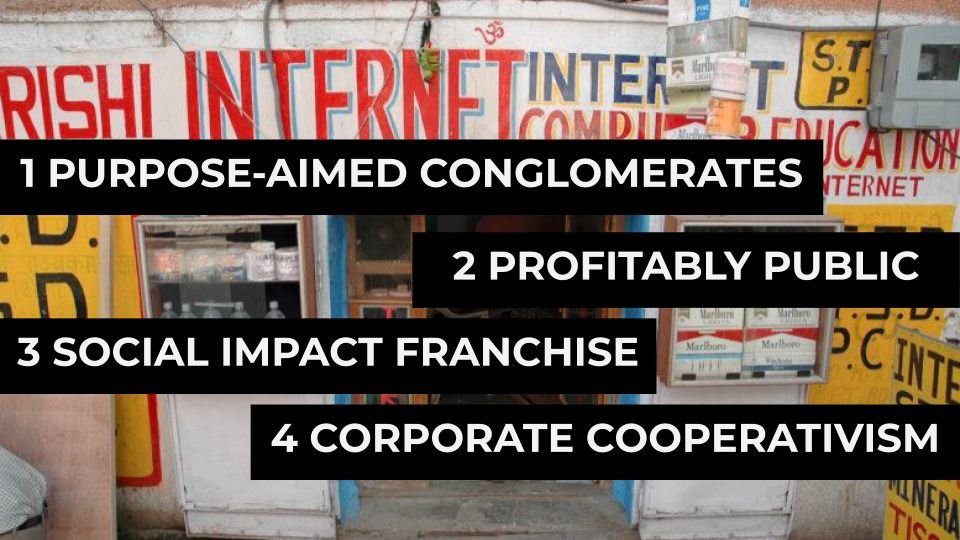
Phase 3: What’s driving microwork
The research team identified what’s driving microwork by analyzing the signals and developing a set of 12 trends. Then the trends were presented at two expert roundtables and in 1:1 interviews with stakeholders. From the feedback, the team identified six changes that are driving microwork.
Change is the process by which the future invades our lives.
– Alvin Toffler, Future Shock (1970)
Participants received the drivers in advance of the first workshop. Not surprisingly, their initial response was frustration and a sense of powerlessness. Next, facilitators led discussions about all six drivers at the workshop. Through discussion, their outlook became more positive. Recognizing that change is fluid and directions can change, gives us more control over our futures.
The “Table talk” section for each driver reflects the group discussions held at the first microwork session. The group chose the drivers 5 & 6 – built for profit + policy lag – as the most significant and most uncertain. Then these were used to develop the scenarios for the second workshop.


Six changes driving microwork

1. Collaborative connections
Working across state and organizational borders keeps getting easier
Billions of people own devices that not long ago would have been supercomputers. They use tools like 5G and Skype to connect, Salesforce and G Suite to coordinate, and Upwork to hire. Working across state and organizational borders also keeps getting easier. It is possible to work with anyone, from anywhere — or break traditional jobs into subcontracted tasks. The result has reshaped everyday work. People spend their days on chat and teleconferences with a remote team of co-workers, freelancers and service providers.
Table talk: collaborative connections
Ana: Our group expressed that “collaborative connections” were an underutilized factor in current forms of microwork, and could potentially be an enabler for future scenarios. Especially pertinent were elements of collaboration that allowed microworkers to advance their collaborative skillset and capture or contribute their individual creativity. Mostly, our group felt that current formats disallowed true collaboration, and they were interested in it increasing it as a driver.
Alastair: This driver was effectively accepted as a given – therefore, important, but not uncertain. So it wasn’t a contender for our group’s choice of two top drivers. However, there was bigger-picture discussion about the various ways that the combination of this driver and “build for-profit” [3] enable the disaggregation of task-level work from the bundles (i.e. “jobs”) they’ve traditionally been delegated in. The observation was that this disaggregation potentially drives both efficiency and inequality.
Marco: My group looked at this driver differently. They viewed the notion of collaboration as a glue, bringing together their two most significant drivers, “policy lag and “unequal growth”. Instead of looking at collaboration through the technical lens it represents, my group saw it as the only way for progress to be made. A perspective that came through strongly as we developed our scenario, The social impact franchise.
Goran: The group felt that this driver was important – although, not the one that was driving the changes. Instead, the group thought that this driver was more of an enabler than a fundamental force that is driving microwork. As a facilitator, this discussion was both surprising and refreshing. The group expressed a shared belief that there were forces other than technological enablement of collaboration that were more essential.

2. Intelligent Advances
We’re training computers to do human work, but cheaper and better.
Computer algorithms connect you with a ride, translate your news, and analyse your medical tests. Sensors, robotics and AR (augmented reality) are becoming part of our everyday lives. But these systems depend on “human intelligence tasks” (HITS). Microtaskers fulfil invisible but essential HITS around the clock and the globe. Their activities also “train” computers to take on ever more complex work. Toronto’s profile as a tech hub is bringing high-paying jobs such as data scientists. These are people who build and support the tech-based systems that are doing human work. Together, data scientists and microtaskers are training computers to do human work, but cheaper and better.
Table talk: intelligent advances
Ana: Our group was unified in their belief that “intelligent advances” are a strong possibility. Therefore we didn’t discuss this driver extensively as there was a reasonably immediate consensus on this point. Notable was the idea that certain types of AI would be beneficial to some (and some types of markets), while disruptive to others (and other types of markets).
Alastair: AI wasn’t a hot topic of discussion – potentially because even the most technical people at our table were primarily business- or policy-side folks. That may have led to either a sense of lack of expertise (which would make it difficult to discuss) or possibly a shared inclination to see it as highly significant, but not necessarily all that mutable. That did lead us to spend some time talking about how inexorable the technical future really was. But the discussion didn’t stay top-of-mind for the group relative to the other drivers. The feeling around the table seemed to be that while robots will probably arrive, the important thing is what we do with them. And that dimension seemed more connected with other drivers.
Marco: AI was considered significant and certain, so the group didn’t spend as much time on it. There was table consensus.
Goran: The group felt that this driver was more fundamental. The automation and AI were actually impacting peoples’ jobs and livelihoods in a way that was aggregative and amplified. It was felt that this would make it necessary to create adoption strategies and active responses that are more pronounced over time. There was also some trepidation about the uncertainty of “intelligent advances”. How exactly they might show up and manifest was noted but not discussed extensively.

3. Social modernization
Alternate ways of living and earning are gaining social acceptance.
1950s ideas about gender, family, identity, and values are fading. Alternate ways of living and earning are gaining social acceptance. Furthermore, many Canadians seek a work and life balance, which is a highly individualized notion. Employers and microwork platforms promote entrepreneurship and flexibility and question the notion of who an employee is. The message of autonomy resonates with many. Yet for some, the notion of work and life balance, of being your own boss, doesn’t quite live up to the promise. The reality is that the microtasking workforce is geographically scattered and demographically diverse. As a result, it is difficult for microworkers to influence pay or terms of work.
Table talk: social modernization
Ana: The group was animated by this driver. We talked about the different ways of being and doing and what it might mean for “social modernization” over time. There was discussion about whether the changes are recurring and self-propagating. They were especially interested in recursive-pattern social shifts. The discussion extended to imagining normative changes to microworkers’ lives. As microworkers become a larger group – and potentially even a majority – the group thought about shifts to values, perception about time, living habits (sleeping and eating), etc. We considered how this type of work might impact the family, technology, health, etc.
Alastair: Our table selected this as one of the two drivers we submitted. One big argument in favour was its role as a distal and deep cause of other changes. Because it wasn’t as obvious how the future might look culturally, those in favour also suggested, its effects could be wide-ranging and unexpected.
Marco: Our group discussion centred on whether alternate ways of earning are real choices at all. Are they simply what many people have to resign themselves to? For example, the notion of the gig economy and its apparent lack of future work, career progression, and income security. We talked about whether “social modernization” as it related to driving microwork is a desire or a reality. Do people feel little control and that they must try to adapt to it?
Goran: The group felt that “social modernization” was in some way also impacted by the previous three drivers. People were seen as responding to the changes in their world and life environments. The underlying energy in this driver was seen as an attempt to situate oneself in this new work environment. To try to find a way to balance experience and social participation. The group expressed concern about positive outcomes given that the tensions being discussed were not easy ones to resolve.

4. Uneven growth
Toronto keeps booming, but not everyone benefits.
Job and population growth mean that Toronto is more diverse, younger, richer and bigger than any other region in Ontario. But Canada’s wealthiest city is an unaffordable “hourglass.” As elite workers thrive, Toronto’s socioeconomic middle is shrinking. A recent study concludes that Toronto has the largest gap between rich and poor in Canada. Furthermore, income inequality disproportionately impacts people who are racialized. Toronto keeps booming, but not everyone benefits. A 2017 report by the United Way and U of T researchers reveals that while “Toronto is fast becoming a world leader in innovation and an example of thriving multiculturalism” it’s growing prosperity also results in “a widening gap between the city’s richest and poorest residents”.
Table talk: uneven growth
Ana: The group was also very intrigued by this driver, and noted that the uneven distribution of growth was a historical fact. They were interested in how specific groups were impacted more highly than others. Also, we talked about how growth might be redistributed to offer value in various ways so that the overall growth is more just and fair. They also expressed the importance of this driver. That ignoring could lead to a negative backlash from adversely affected groups.
Alastair: “Uneven growth” was the other driver selected by our table. People gravitated towards it immediately, several expressing opinions along the lines that “something has to change,” with growing inequality and unaffordability as likely to spark dramatic reforms or shifts. So it had appeal as another deep cause, one that potentially affected and motivated almost everything else we discussed.
Marco: This driver was considered significant, and there was generally a feeling that it is somewhat inevitable. But there was also a desire for change from the table. So there was interest in working on it to think about how it could be addressed.
Goran: The reflection on this driver was that it was more of an outcome than an active generating force. The group felt that the other drivers were effectively creating a change that was experienced as “uneven growth”. The group agreed that it was best not to identify this particular driver as the critical uncertainty since it was more of a result of the interaction of the others.
Voted the top two “what’s driving microwork”
The two drivers below – built for profit and policy lag – were selected from the six microwork drivers as the most significant and most uncertain. Then we applied the opposite direction and a 2×2 matrix, we established the framework for the four Toronto 2030 scenarios.

5. Built for profit
Companies maximize profit by reducing costs.
Most businesses put efficiently maximizing profit over anything else. Companies maximize profit by reducing costs. One way to increase productivity and reduce costs is through automation. Outsourcing is another. Moving jobs to where the cost of doing business is lower can then increase profits. Companies also realize gains by taking advantage of labour’s low cost and bargaining power in poorer countries. Furthermore, they can transfer capital costs to workers and bypass employment standards. On Mechanical Turk the median hourly wage is USD ~2 per hour, and only 4% of workers earn more than USD 7.25 per hour. In 2012, Crowdflower (now Figure Eight) was sued over its labour practices. In 2015, CrowdFlower paid USD 585,507 to settle but the employment status of its workers was unanswered.
Table talk: built for profit
Ana: Our group was divided on the “built for profit” driver. A large portion of our group felt that it might be impossible to change the direction of business-as-usual. Yet, others were optimistic that it all had to change due to necessity. There was a recognition that new types of business models are emerging. Also, a feeling that large numbers of people are becoming change-making leaders (and therefore would spark even more change). The group felt strongly about this driver. They ultimately ended up changing each others’ minds through dialogue. We settled on this being an ample space, full of possibility. That appealing to both do-gooders and the-greedy was the absolute best approach all around. By this, we were referring to models that allow for profit-driven ROI, yet also positive impact.
Alastair: “Build for profit” was a top selection. It triggered lively back-and-forth among table members. Some were optimistic about a perceived increase in public concern for corporate outcomes beyond profit, particularly in terms of a generational transition. Others were sceptical about the effects of social enterprise or cooperative-type efforts, given their relatively small prevalence.
Marco: There was consensus that this driver is significant but also certain. The for-profit model presents an ongoing problem for our table. It is viewed as contributing to income inequality; however, the general consensus was that “business as usual” was unlikely to change.
Goran: The group expressed a great deal of certainty around this driver. They viewed it as representing a set of forces that are more fundamental than the other drivers. This driver was seen to be effectively driving the others. The expectations about profit in corporations were that it is something that few companies could resist if they were to remain competitive. The group viewed the previous drivers (1 and 2) primarily in this context. Ultimately, the “collaborative connections” and “intelligent advances” would be driven by profit motives.

6. Policy lag
Technological shifts have outpaced government policies.
Microtasking is under the radar in Ontario, and so unregulated. Technological shifts have outpaced government policies. As a result, platforms and requesters press their advantages, creating a buyers’ market. Left unregulated, the potential ramifications are broad. The most obvious consideration is adherence to provincial employment standards. The impact also extends to the corporate tax base. Without adequate resources, local prosperity and community safety slide downward. Furthermore, as the social safety net erodes, the need for stable jobs and decent pay rises.
Table talk: policy lag
Ana: Our group was extremely engaged, knowledgeable and passionate about “policy lag”. Some of our group members felt that policy could be doing a lot more to enable-allow-disallow certain types of action. They expressed a desire for the government to engage in a way that reflects current issues. Some people felt that policy lag is inevitable. There was discussion about how entrepreneurs and private corporations can move more quickly than the government. Because they are more nimble in their actions, they can act more immediately. We discussed the way these two approaches impact one another. Entrepreneurial ventures such as Uber have the potential to dis/en/able the status quo.
Alastair: There was quite a bit of initial interest in this driver from several people at the table, but others expressed a degree of exhaustion and ambivalence about discussion focused on regulatory regimes. The general sense was that while individual policies could certainly have dramatic effects, for good or ill, the fundamental question of whether and how government intervened in any technological area would depend on upstream factors. These were discussed as demographics, economics, institutional changes and culture.
Marco: Similar to “unequal growth”, this driver was viewed as significant. There was also a feeling that it is somewhat inevitable, but again, the group expressed a desire for change.
Goran: The group felt that this particular driver was essential, and the other critical uncertainty. There was also some division about whether there is a policy lag. Some of the participants aware of regulatory initiatives. Regardless, the group felt that this driver would significantly alter the microwork experience. Other drivers would show up differently based on policy developments. This extended to “built for profit” and the corporate motivations and mindset.
Contributors
Roundtables
Many thanks to the roundtable participants for their input on the change drivers.
- Susan Brown, Senior Policy Advisor, Economic Development and Culture, City of Toronto
- Wendy Cukier, Professor, Entrepreneurship and Strategy, Ted Rogers School of Management, Ryerson University
- Jen Flexman, Director, Partnerships and Access, Babylon Health (Board member, TWIG)
- Jesse Hirsh, President, Metaviews Media Management
- Anne Jamieson, Senior Manager, Toronto Enterprise Fund, United Way of Greater Toronto
- Kate Kudelka, Senior Project Officer, Futures of Income, Pay & Taxation, Canada Revenue Agency
- Jo-Anne Liburd, Communications Consultant (Chair, Board of Directors, TWIG)
- Han Tran, Director, Bridging Services, ACCES Employment
- Biljana Zuvela, Manager, Research, Public Policy and Evaluation, United Way of Greater Toronto
Workshop 1 participants
- Alison Darcel
- Ann Holmes, Principal Consultant, Ann Holmes & Associates
- Darcy MacCallum, Director of Family & Wellness, The Neighbourhood Organization
- Dhanak Ohri, Undergraduate Student, University of Toronto
- Diane Dyson, Director, Research & Public Policy, The Neighbourhood Group
- Eliana Trinaistic, MCIS Language Solutions
- Geordie McRuer, Founding Consultant, Bastet Strategy
- Gina Lihou, Youth Employment Advisor/Facilitator, St. Stephen’s Community House
- Graham Westwood, CEO, Smashblock
- Han Phu, International Business Development
- Jonquil Eyre, Consultant
- Judy Doidge, Director, Partnerships, Social Capital Partners
- Julian Posada, PhD Student, University of Toronto
- Julyata Mekonnen, Community Access Coordinator, The Neighbourhood Group
- Mahjabeen Mamoon, Lead Research Analyst, Toronto Workforce Innovation Group
- Mazher Jaffery, Consultant
- Michi Komori, Consultant
- Nisa Malli , Senior Policy Analyst, Brookfield Institute for Innovation + Entrepreneurship
- Peter Stoyko, Chief Social Scientist & Information Designer, Elanica
- Rosemary Richings, Rosemary Richings Content Creation & Strategy
- Saddaf Syed, , University of Toronto Scarborough
- Sukanta Goswami
- Tinashe Mafukidze, Executive Director, Toronto Workforce Innovation Group
- Valeria Gallo Montero, Undergraduate Student, University of Toronto
- Yasmeen Awadh, Gig worker
We also want to acknowledge that many people provided one-to-one consultations (and encouragement!) throughout the project.


Foresight process
GETTING TO CHANGE DRIVERS AND SCENARIO BUILDING

Phase 1: Microtasking signals sprint

Phase 2: Microwork trends to consider
Everyone notices trends in the world around them. Spring 2019’s fashion colour was yellow. Meat-free options are on the rise. Part-time work is growing. Sometimes…

Phase 3: What’s driving microwork

Phase 4: Implications of microwork futures

Microwork futures: strategic perspectives
- Microtasking reports - March 12, 2020
- Microtasking project toolkit - March 2, 2020
- Microwork futures: strategic perspectives - February 24, 2020

















